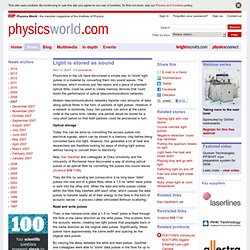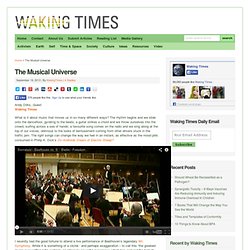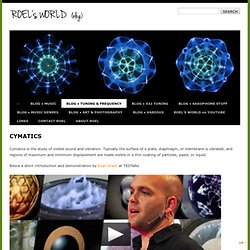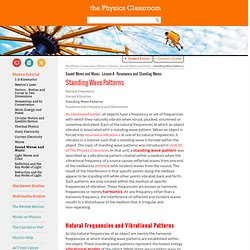

Cymatics Notes. Cymatic Notes II. Sound Waves. The Mysterious Correlation of Light and Sound. Major Chords are Primary Colors... ©2004 gootar - chords theory, By James C.

Cranwell, 04/20/2004 Seven Colors in a Rainbow It is well known there are seven colors in a rainbow... Isaac Newton, a pioneer in the field of colour, passed a beam of sunlight through a prism. When the light came out of the prism it was not white but was spread into rays composed of seven different colours: Red, Orange, Yellow, Green, Blue, Indigo and Violet. The spreading into rays was called dispersion by Newton and he called the different coloured rays the spectrum. Notice the first, third and fifth colors are red, yellow and blue. Seven Notes in a Scale Anyone delving into music theory knows there are seven notes in a musical scale. The mysterious correlation of light and sound.
The first, third and fifth colors of the rainbow are Primary colors... red, yellow and blue. Primary Colors are Major Chords! Special thanks to Google for inadvertently making me think of this, and J.L. Sound Waves Generate Light. LIVERMORE, Calif., March 18, 2009 – High-frequency sounds have been converted into light for the first time, according to scientists at Lawrence Livermore National Laboratory.

By reversing a process that converts electrical signals into sounds, the researchers believe that they have discovered a new tool to enhance the way computer chips, LEDs and transistors are built. They used piezoelectric speakers, which are commonly found in cell phones, because they operate at a low enough frequency for humans to hear. A plasma is generated by a laser pulse similar to how sound is converted to light. (Image: Lawrence Livermore National Laboratory) But by reversing that process, lead researchers Michael Armstrong, Evan Reed and Mike Howard, Lawrence Livermore colleagues, and collaborators from Los Alamos National Laboratory and Nitronex Corp., used a very high frequency sound wave – about 100 million times higher than what humans can hear – to generate light. For more information, visit: www.llnl.gov. Light is stored as sound. Physicists in the US have discovered a simple way to “store” light pulses in a material by converting them into sound waves.

The technique, which involves just two lasers and a piece of standard optical fibre, could be used to create memory devices that could boost the performance of optical telecommunications networks. Modern telecommunications networks transfer vast amounts of data along optical fibres in the form of packets of light pulses. However, if a network is extremely busy, two packets can arrive at the same node at the same time. Ideally, one packet would be stored for a very short period so that both packets could be processed in turn. Optical storage Today this can be done by converting the excess pulses into electrical signals, which can be stored in a memory chip before being converted back into light. They did this by sending two consecutive 2-ns long laser “data” pulses into one end of a glass fibre, while a 1.5 ns “write” laser pulse is sent into the other end. Sound Becomes Light. Researchers at the Lawrence Livermore National Laboratory in California successfully converted sound waves to light radiation by reversing a process that transforms electricity to sound, which is commonly used in cell phones.

This is the first time that sound has been converted to light. The findings, which were published this week in Nature Physics, could improve how computer chips, LEDs, and transistors are made, and also have applications in ultrafast materials science and terahertz radiation (T-ray) generation. The research team initially predicted that the conversion was possible around a year ago, using computer modeling, and has been trying to confirm it in the lab ever since. Converting Sound to Light. Universal Tones - Sleep Tools and Dream Aids - lucid dreams.
The Musical Universe. Andy Dilks, GuestWaking Times What is it about music that moves us in so many different ways?

The rhythm begins and we slide onto the dancefloor, gyrating to the beats; a guitar strikes a chord and we throw ourselves into the crowd, surfing across a sea of hands; a favourite song comes on the radio and we sing along at the top of our voices, oblivious to the looks of bemusement coming from other drivers stuck in the traffic jam. The right songs can change the way we feel in an instant, as effective as the mood pills consumed in Philip K. Dick’s Do Androids Dream of Electric Sheep? I recently had the good fortune to attend a live performance of Beethoven’s legendary 9th Symphony.
This is an example of the immense power music can have over us. The idea that music connects us to something divine and spiritual is not a new one. Cymatics. Cymatics is the study of visible sound and vibration.

Typically the surface of a plate, diaphragm, or membrane is vibrated, and regions of maximum and minimum displacement are made visible in a thin coating of particles, paste, or liquid. Below a short introduction and demonstration by Evan Grant at TEDTalks The study of the patterns produced by vibrating bodies has a venerable history. Leonardo Da Vinci noticed that vibrating a wooden table on which dust lay created various shapes. One of the earliest to record that an oscillating body displayed regular patterns was Galileo Galilei. Evan Grant: Making sound visible through cymatics.
Standing Wave Patterns. As mentioned earlier, all objects have a frequency or set of frequencies with which they naturally vibrate when struck, plucked, strummed or somehow disturbed.

Each of the natural frequencies at which an object vibrates is associated with a standing wave pattern.